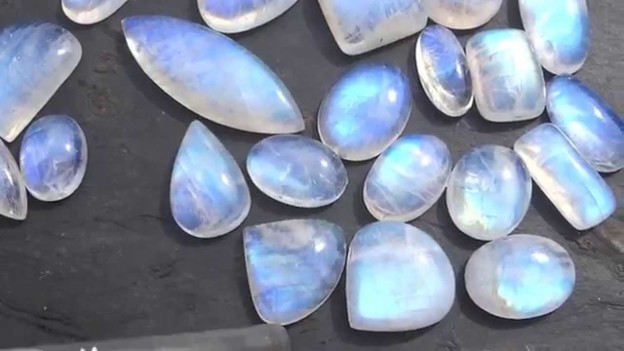Healing Crystal Moonstone Meaning and Uses | Gemstone Meaning
First name
It is also known as Selenite or Adularia, the Moonstone owes its name to its resemblance to the moon. The term Selenite is derived from the Greek “Selene”, which means moon and which in Greek mythology is also the name of the moon goddess. Adularia is the name of a variety of Moonstone native to the European Alps, and from that name derives the name that is given to the optical effect that shows the Moonstone, called “adularity”. In the Hindi language the Moonstone is called “chandrakant”, that is, “the favorite of the moon” and derives from the Sanskrit “chandra” (moon) and “kanta” (favorite).
Chemical composition of Moonstone
The Moonstone is a potassium silicate belonging to the feldspar family, a name that derives from the German “feldspar” and means “fieldstone” for its ability to enrich the soil with fertilizer substances for vegetation. The feldspar is a family of minerals particularly known for its gems, which present beautiful optical phenomena with modularity, adventure science or labradorescencia. Its two subgroups are plagioclase and potassium. The first group is characterized by the percentage of calcium and sodium and comprises most of the gems. The precious stones that belong to the potassium group have in common the chemical composition, but they point out a different crystalline structure. It is important to remember that many feldspar gems are similar, sometimes even confused by gemologists because of their similar chemical composition. The Moonstone, for example, It is closely linked to Labradorite and Sunstone.
Extraction of the Moonstone
The deposits of Piedra de Luna are few and isolated. They are found in Brazil, Burma, the European Alps, India, Madagascar, Sri Lanka, Tanzania and the USA, which makes it a rare gem. Sri Lanka is famous for being the main producer of Piedra de Luna of superior quality, almost transparent and with a strong blue brightness. Most of the Moonstone extracted in Sri Lanka comes from the famous Meetiyagoda mine in the south of the island, but it is also extracted in Dumbara, Tissamaharama, and Imbulpe. Although Meetiyagoda has been active for more than 50 years, the still active deposits are scarce. Therefore, although this gem belongs to the most abundant mineral group on earth, in reality, it is very rare as Precious Stone.
The Moonstone found in Tanzania is a relatively new variety; it is extracted in the Arusha region, where Tanzanite is also extracted.
History, traditions, and beliefs of the Moonstone
Many are the traditions and legends that feature this wonderful gem, from ancient India, where it was believed that the four-armed Hindu goddess had a Moonstone on her forehead, as a representation of the Moon itself. By superstition and after its particular colors, it was supposed that whoever possessed it would obtain the beneficent divine influence. Also in the West the Moonstone has been much loved and precious: the ancients believed that it was composed of small elements of the moon and that its internal light would be the light of a positive deity, present in the gem. In ancient Rome, it was thought that according to the various lunar phases the Moonstone changed its appearance and that at a certain moment it was possible to glimpse the image of the goddess Diana inside it. A medieval legend affirms that who had fallen asleep after having seen a Moonstone would have enjoyed the faculties of a fortune-teller. Since always look like a female gem and “goddess”, therefore it is not surprising that in mythology the art of guessing was traditionally taken by a female art par excellence.
New Age Healing Products Suppliers
Along with these traditions, the Moonstone has been associated with the most powerful and positive emotion: love. As a symbol of the “third eye”, the Moonstone would be able to balance yin and Yang, protect from epilepsy and ensure a good harvest. For the crystal, therapy is a gem that would help men to approach their female part.
Characteristics of the Moonstone
The Moonstone comes in a wide variety of colors, including brown, colorless, green, gray, pink, rainbow, white and yellow. It has a brightness that goes from silver to blue, varies from semi-translucent to translucent and often displays a high luminosity. The most sought-after specimens of Piedra de Luna are characterized by their intense blue shine that slides on the surface of the gem when the angle of observation varies, a high purity and a colorless background. In general terms, the more intense the blue brightness and the greater its transparency, the higher the value – and the price – of the Moonstone.
Variety of Moonstone
The Moonstone Rainbow has a wonderful adularity of an intense blue. It is a variety of feldspar with the same composition as Labradorite. It is extracted mainly in Sri Lanka and its characteristic resides in the exceptional clarity of its crystals.
The Labradorite owes its name to the Labrador Peninsula, in Canada, where it was discovered for the first time. It is plagioclase feldspar that is also extracted in China, India, and Madagascar. It is also found in transparent specimens, (usually red, orange, yellow or colorless) and with a spectacular adularity, in this case, called “labradorescencia”.
The Piedra Del Sol is plagioclase feldspar typically yellow, pink, orange, red or colorless. Its most important attribute is the adventure scene that is the beautiful effect of “sunlight” produced by tiny metallic inclusions. It is extracted mainly in India, Madagascar and the USA. The Stone of the Sun was coveted in a distant time because of its supposed power to guide in the journey of life to those who carried it with them.

